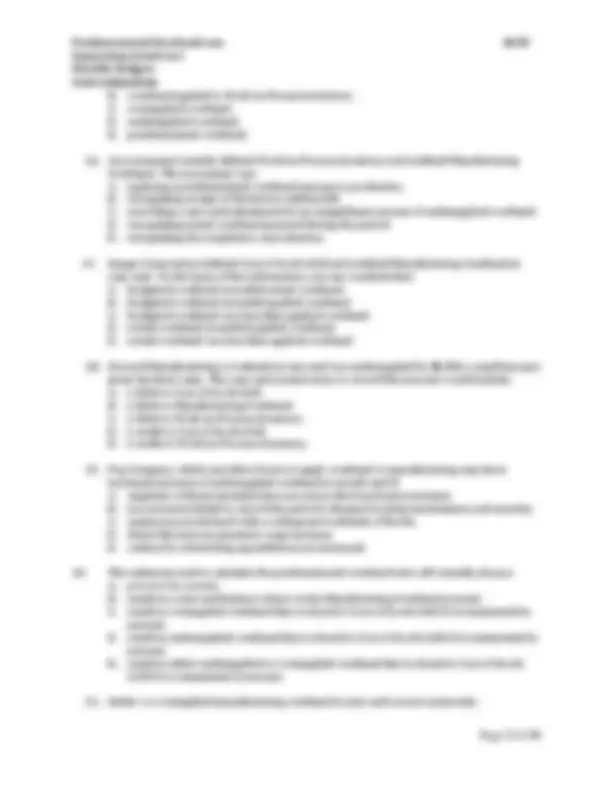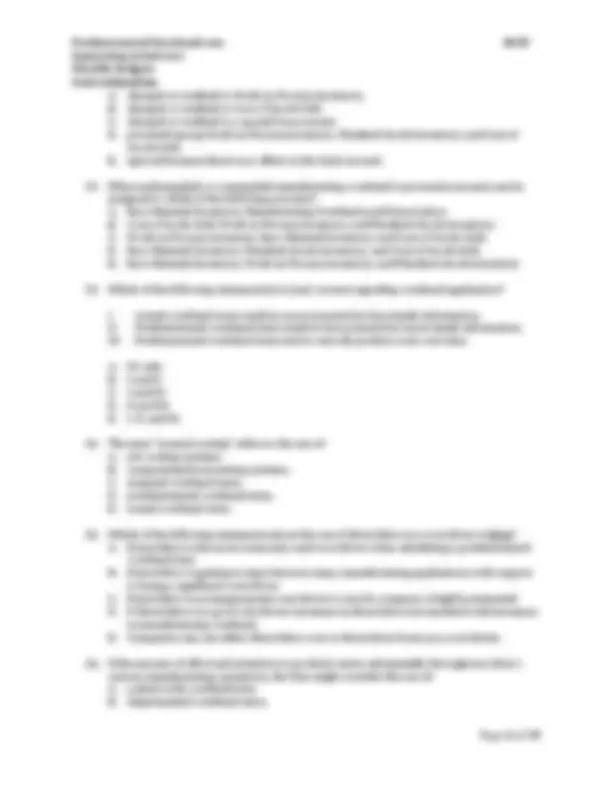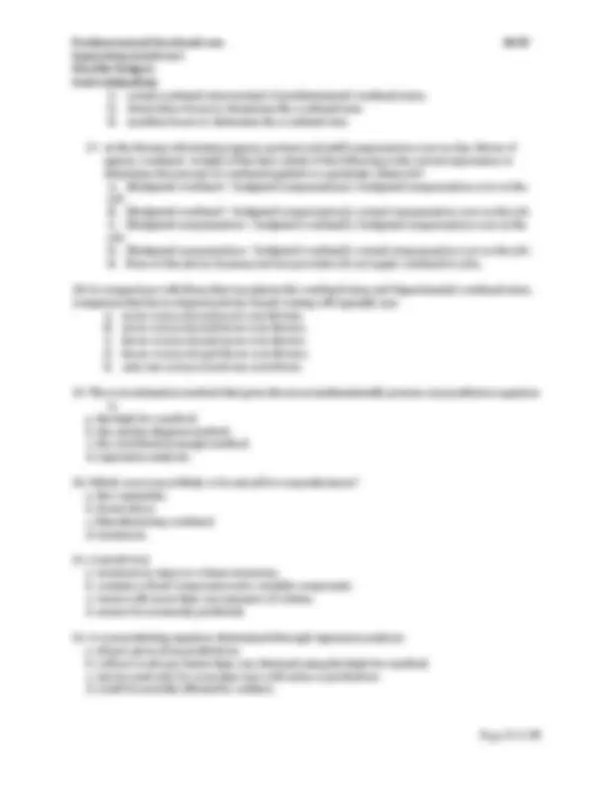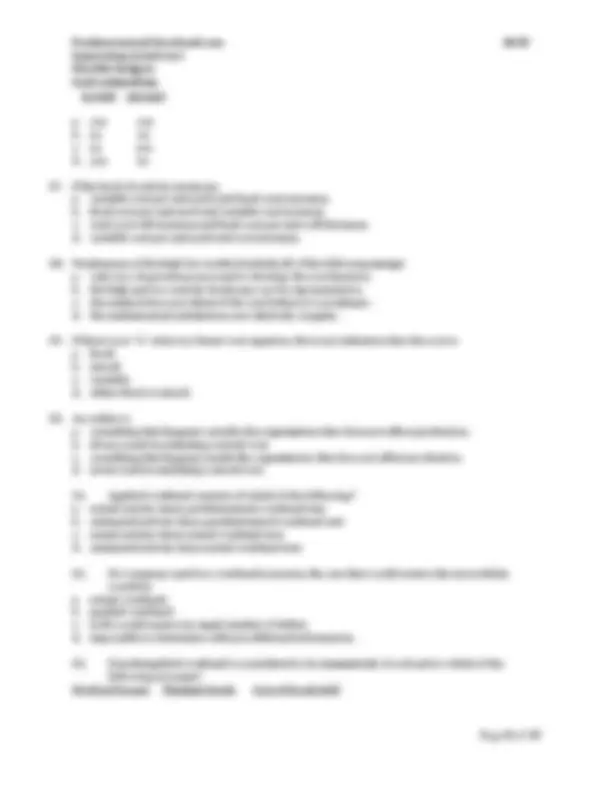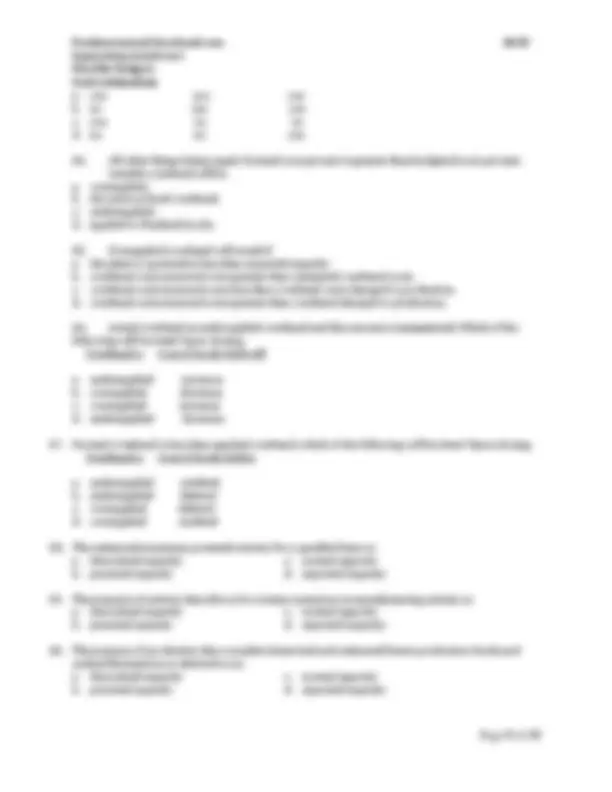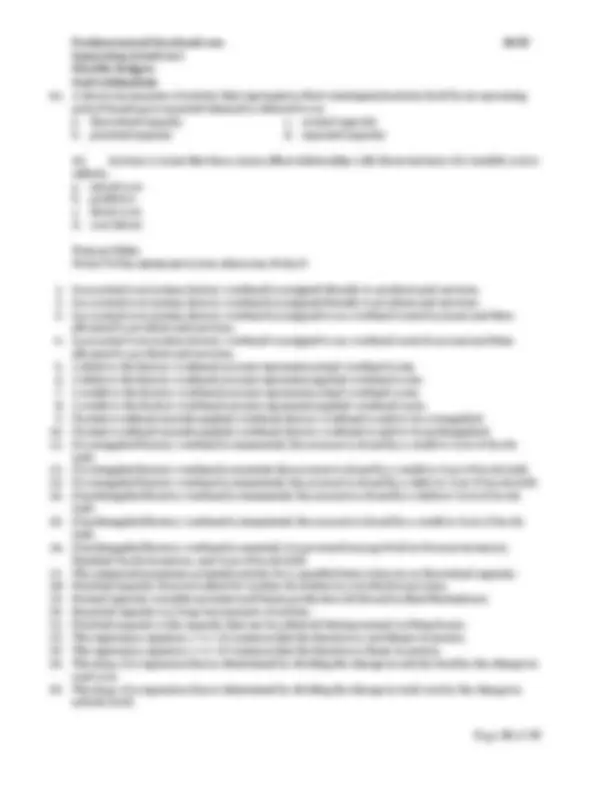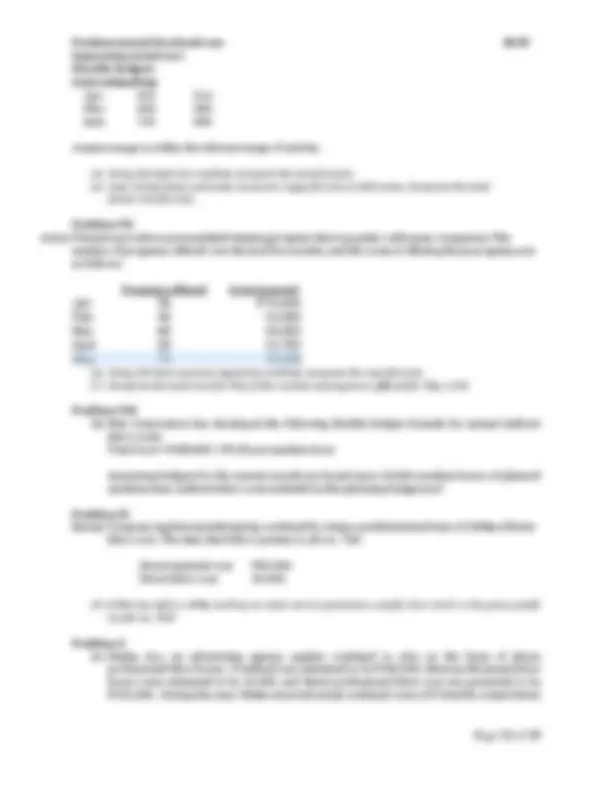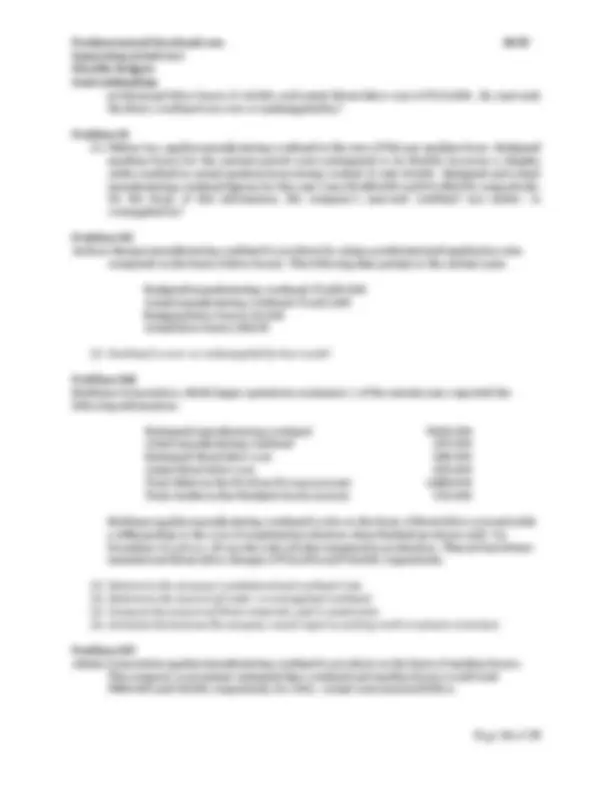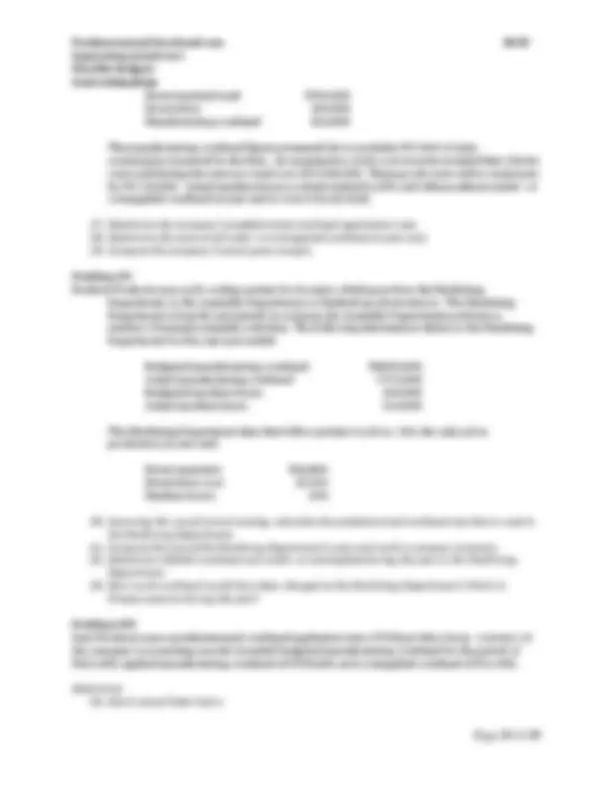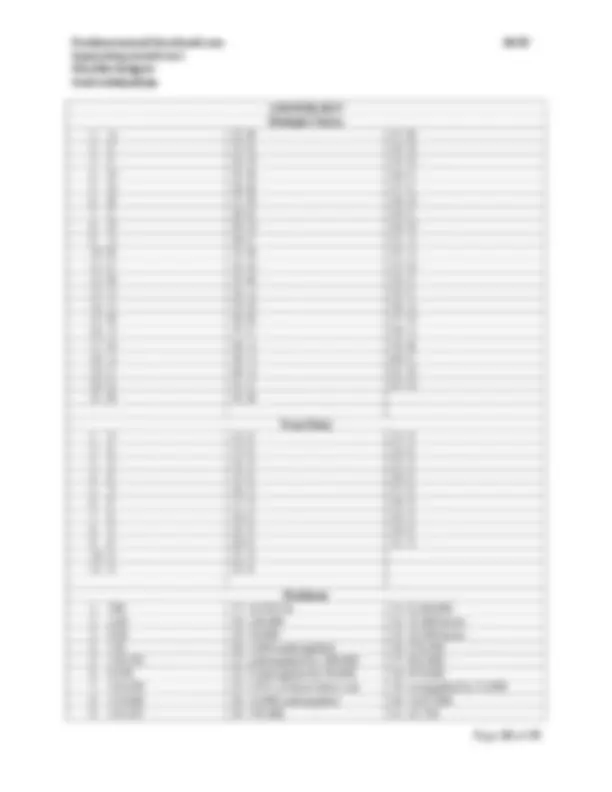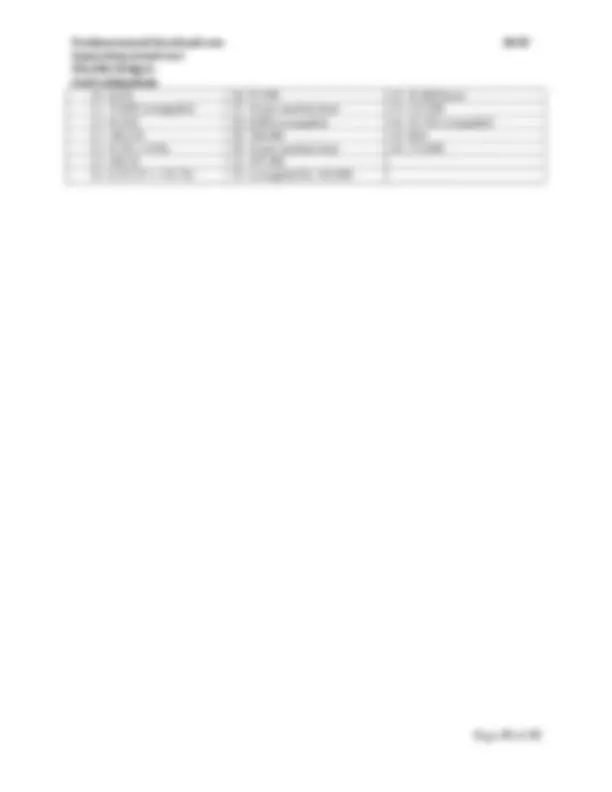Download Cost Accounting: Overhead Rate, Mixed Cost Separation, Flexible Budgets, & Estimation and more Study notes Cost Accounting in PDF only on Docsity!
Separating mixed cost Flexible budgets
Cost estimation
[COST ACCOUNTING]
Predetermined Overhead rate Separating mixed cost Flexible budgets Cost estimation
I. Theories
- For analysis purposes, the high-low method usually produces a(n) A. reasonable estimate. C. overstated estimate. B. precise estimate. D. understated estimate.
- The high-low method is criticized because it A. is not a graphical method. B. is a mathematical method. C. ignores much of the available data by concentrating on only the extreme points. D. does not provide reasonable estimates.
- The high-low method may give unsatisfactory results if A. the data points all fall on a line. C. the points are not representative. B. volume of activity is heavy. D. volume of activity is light.
- Weaknesses of the high-low method include all of the following except A. Only two observations are used to develop the cost function. B. The high and low activity levels may not be representative. C. the method does not detect if the cost behavior is nonlinear. D. the mathematical calculations are relatively complex.
- The cost estimation method that gives the most mathematically precise cost prediction equation is A. the high-low method C. the scatter-diagram method B. the contribution margin method D. regression analysis
- Regression analysis is better than the high-low method of cost estimation because regression analysis: A. is more mathematical. C. fits its data into a mathematical equation. B. uses all the data points, not just two. D. takes more time to do.
- In regression analysis, what does the variable "X" stand for in the model Y = a + bX + e? A. The amount of the dependent variable, the cost to be estimated. B. The regression error, which is the distance between the regression line and the data point. C. The value for the independent variable, the cost driver for the cost to be estimated; there may be one or more cost drivers. D. The unit variable cost, also called the coefficient of the independent variable.
- A cost-predicting equation determined through regression analysis A. always gives close predictions.
Separating mixed cost Flexible budgets
Cost estimation
B. will not work any better than one obtained using the high-low method. C. can be used only for costs that vary with sales of production. D. could be severely affected by outliers.
- The closeness of the relationship between the cost and the activity is called A. correlation C. spurious B. regression analysis D. manufacturing overhead
- Advantages of the method of least squares over the high-low method include all of the following except A. a statistical method is used to mathematically derive the cost function B. only two points are used to develop the cost function C. the squared differences between actual observations and the line (cost function) are minimized D. all the observations have an effect on the cost function
- The process of assigning overhead costs to the jobs that are worked on is commonly called: A. service department cost allocation. B. overhead cost distribution. C. overhead application. D. transfer costing. E. overhead cost apportionment.
- Which of the following is the correct method to calculate a predetermined overhead rate? A. Budgeted total manufacturing cost ÷ budgeted amount of cost driver. B. Budgeted overhead cost ÷ budgeted amount of cost driver. C. Budgeted amount of cost driver ÷ budgeted overhead cost. D. Actual overhead cost ÷ budgeted amount of cost driver. E. Actual overhead cost ÷ actual amount of cost driver.
- Metro Corporation uses a predetermined overhead rate of $20 per machine hour. In deriving this figure, the company's accountant used: A. a denominator of budgeted machine hours for the current accounting period. B. a denominator of actual machine hours for the current accounting period. C. a denominator of actual machine hours for the previous accounting period. D. a numerator of budgeted machine hours for the current accounting period. E. a numerator of actual machine hours for the current accounting period.
- The left side of the Manufacturing Overhead account is used to accumulate: A. actual manufacturing overhead costs incurred throughout the accounting period. B. overhead applied to Work-in-Process Inventory. C. underapplied overhead. D. predetermined overhead. E. overapplied overhead.
- Throughout the accounting period, the credit side of the Manufacturing Overhead account is used to accumulate: A. actual manufacturing overhead costs.
Separating mixed cost Flexible budgets
Cost estimation
A. charged or credited to Work-in-Process Inventory. B. charged or credited to Cost of Goods Sold. C. charged or credited to a special loss account. D. prorated among Work-in-Process Inventory, Finished-Goods Inventory, and Cost of Goods Sold. E. ignored because there is no effect on the Cash account.
- When underapplied or overapplied manufacturing overhead is prorated, amounts can be assigned to which of the following accounts? A. Raw-Material Inventory, Manufacturing Overhead, and Direct Labor. B. Cost of Goods Sold, Work-in-Process Inventory, and Finished-Goods Inventory. C. Work-in-Process Inventory, Raw-Material Inventory, and Cost of Goods Sold. D. Raw-Material Inventory, Finished-Goods Inventory, and Cost of Goods Sold. E. Raw-Material Inventory, Work-in-Process Inventory, and Finished-Goods Inventory
- Which of the following statement(s) is (are) correct regarding overhead application?
I. Actual overhead rates result in more accurate but less timely information. II. Predetermined overhead rates result in less accurate but more timely information. III. Predetermined overhead rates tend to smooth product costs over time.
A. III only. B. I and II. C. I and III. D. II and III. E. I, II, and III.
- The term "normal costing" refers to the use of: A. job-costing systems. B. computerized accounting systems. C. targeted overhead rates. D. predetermined overhead rates. E. actual overhead rates.
- Which of the following statements about the use of direct labor as a cost driver is false? A. Direct labor is the most commonly used cost driver when calculating a predetermined overhead rate. B. Direct labor is gaining in importance in many manufacturing applications with respect to being a significant cost driver. C. Direct labor is an inappropriate cost driver to use if a company is highly automated. D. If direct labor is a good cost driver, increases in direct labor are matched with increases in manufacturing overhead. E. Companies can use either direct labor cost or direct labor hours as a cost driver.
- If the amount of effort and attention to products varies substantially throughout a firm's various manufacturing operations, the firm might consider the use of: A. a plant-wide overhead rate. B. departmental overhead rates.
Separating mixed cost Flexible budgets
Cost estimation
C. actual overhead rates instead of predetermined overhead rates. D. direct labor hours to determine the overhead rate. E. machine hours to determine the overhead rate.
- At the Nassau Advertising Agency, partner and staff compensation cost is a key driver of agency overhead. In light of this fact, which of the following is the correct expression to determine the amount of overhead applied to a particular client job? A. (Budgeted overhead ÷ budgeted compensation) x budgeted compensation cost on the job. B. (Budgeted overhead ÷ budgeted compensation) x actual compensation cost on the job. C. (Budgeted compensation ÷ budgeted overhead) x budgeted compensation cost on the job. D. (Budgeted compensation ÷ budgeted overhead) x actual compensation cost on the job. E. None of the above, because service providers do not apply overhead to jobs.
- In comparison with firms that use plantwide overhead rates and departmental overhead rates, companies that have adopted activity-based costing will typically use: A. more cost pools and more cost drivers. B. more cost pools and fewer cost drivers. C. fewer cost pools and more cost drivers. D. fewer cost pools and fewer cost drivers. E. only one cost pool and one cost driver.
- The cost estimation method that gives the most mathematically precise cost prediction equation is a. the high-low method. b. the scatter-diagram method. c. the contribution margin method. d. regression analysis.
- Which cost is most likely to be mixed for a manufacturer? a. Raw materials. b. Direct labor. c. Manufacturing overhead. d. Insurance.
- A mixed cost a. increases in steps as volume increases. b. contains a fixed component and a variable component. c. varies with more than one measure of volume. d. cannot be accurately predicted.
- A cost-predicting equation determined through regression analysis a. always gives close predictions. b. will not work any better than one obtained using the high-low method. c. can be used only for costs that vary with sales or production. d. could be severely affected by outliers.
Separating mixed cost Flexible budgets
Cost estimation
c. to minimize the overhead cost assigned to products. d. to maximize the overhead cost assigned to products.
- Which of the following is not a reason to use predetermined overhead rates? a. to overcome the problems of assigning overhead to diverse types of products b. to compensate for fluctuations in monthly overhead costs c. to provide a means for assigning overhead during the period rather than at the end of the period d. to smooth out the amount of overhead cost assigned to products when monthly production activity differs
- When a manufacturing company has a highly automated manufacturing plant producing many different products, which of the following is the more appropriate basis of applying manufacturing overhead costs to work in process? a. direct labor hours b. direct labor dollars c. machine hours d. cost of materials used
- A mixed cost has which of the following components? Variable component Fixed component
a. yes no b. yes yes c. no no d. no yes
- In the formula y = a + bX, y represents a. fixed costs. b. total cost. c. variable costs. d. mixed costs.
- In the formula y = a + bX, a represents a. mixed cost. b. variable cost. c. total cost. d. fixed cost.
- In relationship to changes in activity, variable overhead changes in total per unit
a. no no b. no yes c. yes yes d. yes no
- In relationship to changes in activity, fixed overhead changes
Separating mixed cost Flexible budgets
Cost estimation
in total per unit
a. yes yes b. no no c. no yes d. yes no
- If the level of activity increases, a. variable cost per unit and total fixed costs increase. b. fixed cost per unit and total variable cost increase. c. total cost will increase and fixed cost per unit will decrease. d. variable cost per unit and total cost increase.
- Weaknesses of the high-low method include all of the following except a. only two observations are used to develop the cost function. b. the high and low activity levels may not be representative. c. the method does not detect if the cost behavior is nonlinear. d. the mathematical calculations are relatively complex.
- If there is no "a" value in a linear cost equation, this is an indication that the cost is a. fixed. b. mixed. c. variable. d. either fixed or mixed.
- An outlier is a. something that happens outside the organization that does not affect production. b. always used in analyzing a mixed cost. c. something that happens inside the organization that does not affect production. d. never used in analyzing a mixed cost.
- Applied overhead consists of which of the following? a. actual activity times predetermined overhead rate b. estimated activity times predetermined overhead rate c. actual activity times actual overhead rate d. estimated activity times actual overhead rate
- If a company used two overhead accounts, the one that would receive the most debits would be a. actual overhead. b. applied overhead. c. both would receive an equal number of debits. d. impossible to determine without additional information.
- If underapplied overhead is considered to be immaterial , it is closed to which of the following accounts? Work in Process Finished Goods Cost of Goods Sold
Separating mixed cost Flexible budgets
Cost estimation
- A short-run measure of activity that represents a firm’s anticipated activity level for an upcoming period based upon expected demand is referred to as: a. theoretical capacity c. normal capacity b. practical capacity d. expected capacity
- An item or event that has a cause-effect relationship with the incurrence of a variable cost is called a a. mixed cost. b. predictor. c. direct cost. d. cost driver.
True or False Write T if the statement is true otherwise, Write F.
- In an actual cost system, factory overhead is assigned directly to products and services.
- In a normal cost system, factory overhead is assigned directly to products and services.
- In a normal cost system, factory overhead is assigned to an overhead control account and then allocated to products and services.
- In an actual cost system, factory overhead is assigned to an overhead control account and then allocated to products and services.
- A debit to the factory overhead account represents actual overhead costs.
- A debit to the factory overhead account represents applied overhead costs.
- A credit to the factory overhead account represents actual overhead costs.
- A credit to the factory overhead account represents applied overhead costs.
- If actual overhead exceeds applied overhead, factory overhead is said to be overapplied.
- If actual overhead exceeds applied overhead, factory overhead is said to be underapplied.
- If overapplied factory overhead is immaterial, the account is closed by a credit to Cost of Goods Sold.
- If overapplied factory overhead is material, the account is closed by a credit to Cost of Goods Sold.
- If overapplied factory overhead is immaterial, the account is closed by a debit to Cost of Goods Sold.
- If underapplied factory overhead is immaterial, the account is closed by a debit to Cost of Goods Sold.
- If underapplied factory overhead is immaterial, the account is closed by a credit to Cost of Goods Sold.
- If underapplied factory overhead is material, it is prorated among Work in Process Inventory, Finished Goods Inventory, and Cost of Goods Sold.
- The estimated maximum potential activity for a specified time is known as theoretical capacity.
- Practical capacity does not adjust for routine downtime in a production process.
- Normal capacity considers present and future production levels and cyclical fluctuations.
- Expected capacity is a long-run measure of activity.
- Practical capacity is the capacity that can be achieved during normal working hours.
- The regression equation y = a+ bX assumes that the function is curvilinear in nature.
- The regression equation y = a+ bX assumes that the function is linear in nature.
- The slope of a regression line is determined by dividing the change in activity level by the change in total cost.
- The slope of a regression line is determined by dividing the change in total cost by the change in activity level.
Separating mixed cost Flexible budgets
Cost estimation
- The high-low method excludes outliers from the calculation of the slope of a regression line.
- When using the high-low method, fixed costs are computed before the variable component is computed.
- When using the high-low method, the variable component is computed before the fixed component is.
- A flexible budget is a planning document that presents expected variable and fixed overhead costs at different activity levels.
- Plantwide overhead rates provide a more accurate computation of factory overhead than departmental overhead rates
- Plantwide overhead rates provide a less accurate computation of factory overhead than departmental overhead rates
Problems
Problem I Birmingham Machine Works had the following data regarding monthly power costs:
Month Machine hours Power cost Jun 300 P Jul 600 720 Aug 400 695 Sept. 200 640
1_. Assume that management expects 500 machine hours in October. Using the high-low method, calculate October’s power cost using machine hours as the basis for prediction._
Problem II
- Walton Corporation wishes to develop a single predetermined overhead rate. The company's expected annual fixed overhead is P340,000 and its variable overhead cost per machine hour is P 2. The company's relevant range is from 200,000 to 600,000 machine hours. Walton expects to operate at 425,000 machine hours for the coming year. The plant's theoretical capacity is 850,000. The predetermined overhead rate per machine hour should be?
Problem III Burke Corporation has the following data for use of its machinery
Month Usage Cost Jun 600 P Jul 650 775 Aug 420 550 Sept 500 650 Oct 450 570
_3. Using the high-low method, compute the variable cost element.
- Using the high-low method, compute the fixed cost element (to the nearest whole peso)._
Problem IV
Separating mixed cost Flexible budgets
Cost estimation
Apr. 425 310 May 450 380 June 725 484
Assume usage is within the relevant range of activity.
_14. Using the high-low method, compute the cost formula.
- Leon Corporation estimates its power usage for July at 660 watts. Compute the total_ power cost for July.
Problem VII Action Trainers provides a personalized training program that is popular with many companies. The number of programs offered over the last five months, and the costs of offering these programs are as follows:
Programs Offered Costs Incurred
Jan 55 P15,
Feb 45 14,
Mar 60 18,
April 50 14,
May 75 19,
_16. Using the least-squares regression method, compute the cost formula.
- Compute the total cost for May if the number of programs offered for May is 59._
Problem VIII
- Nite Corporation has developed the following flexible budget formula for annual indirect labor costs: Total Cost = P480,000 + P5.00 per machine hour
Operating budgets for the current month are based upon 20,000 machine hours of planned machine time. Indirect labor costs included in this planning budget are?
Problem IX Barney Company applies manufacturing overhead by using a predetermined rate of 200% of direct labor cost. The data that follow pertain to job no. 764:
Direct material cost P55, Direct labor cost 40,
19. If Barney adds a 40% markup on total cost to generate a profit, how much is the gross profit on job no. 764?
Problem X
- Media, Inc., an advertising agency, applies overhead to jobs on the basis of direct professional labor hours. Overhead was estimated to be P150,000, direct professional labor hours were estimated to be 15,000, and direct professional labor cost was projected to be P225,000. During the year, Media incurred actual overhead costs of P146,000, actual direct
Separating mixed cost Flexible budgets
Cost estimation
professional labor hours of 14,500, and actual direct labor cost of P222,000. By year-end, the firm's overhead was over or underapplied by?
Problem XI
- Maher, Inc., applies manufacturing overhead at the rate of P60 per machine hour. Budgeted machine hours for the current period were anticipated to be 80,000; however, a lengthy strike resulted in actual machine hours being worked of only 65,000. Budgeted and actual manufacturing overhead figures for the year were P4,800,000 and P4,180,000, respectively. On the basis of this information, the company's year-end overhead was under- or overapplied by?
Problem XII Carlson charges manufacturing overhead to products by using a predetermined application rate, computed on the basis of labor hours. The following data pertain to the current year:
Budgeted manufacturing overhead: P1,600, Actual manufacturing overhead: P1,632, Budgeted labor hours: 50, Actual labor hours: 48,
22. Overhead is over- or underapplied by how much?
Problem XIII Brickman Corporation, which began operations on January 1 of the current year, reported the following information:
Estimated manufacturing overhead P600, Actual manufacturing overhead 639, Estimated direct labor cost 480, Actual direct labor cost 500, Total debits in the Work-in-Process account 1,880, Total credits in the Finished-Goods account 920,
Brickman applies manufacturing overhead to jobs on the basis of direct labor cost and adds a 60% markup to the cost of completed production when finished goods are sold. On December 31, job no. 18 was the only job that remained in production. That job had direct- material and direct-labor charges of P16,500 and P36,000, respectively.
_23. Determine the company’s predetermined overhead rate.
- Determine the amount of under- or overapplied overhead.
- Compute the amount of direct materials used in production.
- Calculate the balance the company would report as ending work-in-process inventory._
Problem XIV Athens Corporation applies manufacturing overhead to products on the basis of machine hours. The company's accountant estimated that overhead and machine hours would total P800,000 and 50,000, respectively, for 2001. Actual costs incurred follow.
Separating mixed cost Flexible budgets
Cost estimation
_35. Kent’s budgeted labor hours.
- Kent’s actual manufacturing overhead._
Problem XVII A review of the records of Milgrim, Inc., a new company, disclosed the following year-end information: Manufacturing Overhead account: Contained debits of P872,000, which included P20,000 of sales commissions. Work-in-Process Inventory account: Contained charges for overhead of P875,000. Cost-of-Goods-Sold account: Contained a year-end debit balance of P3,680,000. This amount was computed prior to any year-end adjustment for under- or overapplied overhead.
Milgrim applies manufacturing overhead to production by using a predetermined rate of P 20 per machine hour. Budgeted overhead for the period was anticipated to be P900,000.
_37. Determine the actual manufacturing overhead for the year.
- Determine the amount of manufacturing overhead applied to production.
- Is overhead under- or overapplied? By how much?
- Compute the adjusted cost-of-goods-sold figure that should be disclosed on the company's_ _income statement.
- How many machine hours did Milgrim actually work during the year?
- Compute budgeted machine hours for the year._
Problem XVIII Fine & Associates is an interior decorating firm in Tucson. The following costs were incurred in a project to redecorate the mayor's offices:
Direct material P 29, Direct professional labor 42,
The firm's budget for the year included the following estimates:
Budgeted overhead P800, Budgeted direct professional labor
Overhead is applied to contracts by using a predetermined overhead rate that is based on direct professional labor cost. Actual professional labor during the year was P655,000 and actual overhead was P793,000.
_43. Determine the total cost to redecorate the mayor's offices.
- Calculate the under- or overapplied overhead for the year._
Problem XIX Genner Company earned P125,000 on sales of P750,000. It earned P225,000 on sales of P1,000,000.
Separating mixed cost Flexible budgets
Cost estimation
_45. Find the variable costs as a percentage of sales.
- Find the total fixed costs._
“Failure is the opportunity to begin again more intelligently.” ~ Henry Ford
Separating mixed cost Flexible budgets
Cost estimation
- 8,934 26. 97,500 42. 45,000 hours
- 75,000 overapplied 27. 16 per machine hour 43. 123,
- 85,426 28. 8,000 overapplied 44. 25,750 overapplied
- 180,318 29. 768,000 45. 60%
- 63.50 + 0.58x 30. 16 per machine hour 46. 175,
- 446.30 31. 107,
- 6,152.97 + 176.79x 32. overapplied by 185,

